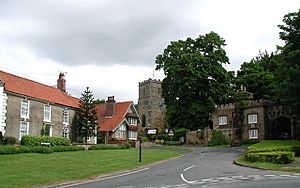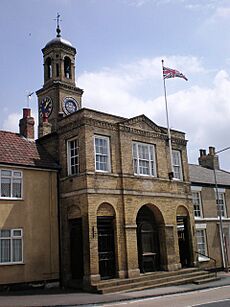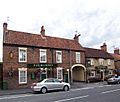South Cave facts for kids
Quick facts for kids South Cave |
|
|---|---|
 Church Hill, South Cave |
|
| Population | 4,823 (2011 census) |
| OS grid reference | SE925312 |
| • London | 155 mi (249 km) S |
| Civil parish |
|
| Unitary authority | |
| Ceremonial county | |
| Region | |
| Country | England |
| Sovereign state | United Kingdom |
| Post town | BROUGH |
| Postcode district | HU15 |
| Dialling code | 01430 |
| Police | Humberside |
| Fire | Humberside |
| Ambulance | Yorkshire |
| EU Parliament | Yorkshire and the Humber |
| UK Parliament |
|
South Cave is a small village in the East Riding of Yorkshire, England. It's about 23 kilometers (14 miles) west of Hull. You can find it near the A1034 and A63 roads. Another village, North Cave, is just 3 kilometers (2 miles) to the northwest. South Cave used to be called a town, but now it's officially a village.
The area called South Cave includes the main village, plus smaller places like Drewton and part of Riplingham. In 2011, about 4,823 people lived in South Cave. This was more than the 4,515 people counted in 2001. South Cave is part of the Haltemprice and Howden area for Parliament.
Contents
A Look Back in Time
The name 'Cave' likely comes from an old English word meaning "quick" or "swift." This might refer to a fast-flowing stream.
South Cave is mentioned in the famous Domesday Book. This was a big survey of England done in 1086. Back then, it was simply called "Cave." The survey showed there were 31 homes, 30 villagers, and a priest. There were also fields for farming, woodlands, and a church. In 1066, a person named Gamal owned the land. By 1086, it was owned by Robert Malet, who worked for King William I. The South Cave Town Hall building was built much later, in 1796.
In 1823, South Cave was a busy town. It had a market every Monday where lots of corn was sold. This corn was sent to other towns like Leeds and Wakefield. Things like coal and stone were brought back to South Cave.
Famous Connections
There's a special connection to American history in South Cave! Cave Castle, which was near the town, was once home to the family of George Washington. He was the first President of the United States. His great-grandfather lived at the castle and owned part of the land before moving to America in 1657.
Life in South Cave
The Yorkshire Wolds Way is a long walking path that goes near the east side of the village. It's a great place for hikers!
The local church is called All Saints' Church. It's a very old building, listed as a Grade II* historic building in 1968. This means it's very important. The Methodist Church joined with All Saints Church in 2007.
Cave Castle Today
Cave Castle was built in 1804. It looks like an old castle, built in the Gothic Revival style. It's also a Grade II listed building. Today, Cave Castle is a hotel with a gym. Its beautiful grounds are now a local golf club.
In 2003, the area around South Cave was ranked as one of the wealthiest in the country.
Sports and Community
South Cave has a strong community spirit, especially when it comes to sports.
Since 2010, the Sporting Club and the South Cave & Brantingham Cricket Club have been based at the Norman Elliott Pavilion. This building was finished in 2012 after people raised a lot of money for it. The Pavilion cost £730,000 to build and was named after Norman Elliott, a local hero.
Images for kids
See also
 In Spanish: South Cave para niños
In Spanish: South Cave para niños






